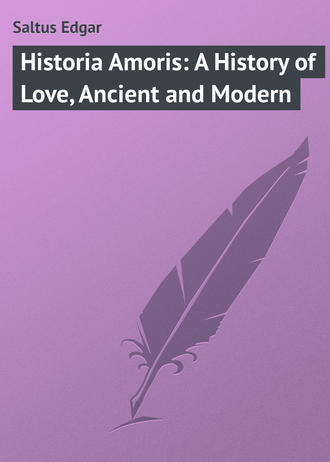 полная версия
полная версияHistoria Amoris: A History of Love, Ancient and Modern
Before chivalry departed and very shortly after it appeared, that joy, lifted into joie d’amour, glowed like a rose in the gloom of the world. It humanized very notably. It dismissed much that was dark. It brought graces hitherto unknown. It inspired loyalty, fealty and parage – the nobility of noble pride – but particularly the worship of woman.
In the East, woman had also been worshipped. But not as she was in Europe at this period. At no epoch since has she been as sovereign. Set figuratively with the high virtues in high figurative spheres, she ruled on earth only less fully than she reigned in heaven. The cultus, instituted first by the troubadours, then adopted by royals, connected consequently with pride of place, became fashionable among an aristocracy for whose convenience the rest of humanity labored. Too elevating for the materialism of the age that had gone and too elevated for the democracy of the age that followed, it was comparable to a precipitate of the chemistry of the soul projected into the heart of a life splendid and impermanent, a form of existence impossible before, impossible since, a social order very valiant, very courteous, to which the sense of rectitude had not come but in which joy, unparalleled in history, really, if unequally, abounded. Never more obvious, never either was it more obscure. It was abstruse. It had its laws, its jurists, its tribunals and its code.
Chivalry required of the novice various proofs and preliminaries before admitting him to knighthood. The gay science had also its requirements, preparatory tests which young men of quality gave and primary instruction which they received, before their novitiate could terminate. The tests related to women married and single. By address in the lists, by valor in war, by constant courtesy and loyalty, it was the duty of the aspirant to please them. Pending the novitiate no word of love was permitted and any advancement might be lost through an awkwardness of speech or gesture. But the caprices of a lady properly endured and the tests undergone unfalteringly, relations might ensue, in which case, if the lady were single, the connection was not thought contrary to the best traditions, provided that it was a prelude to marriage, nor, if the lady were already married was it thought at variance with those traditions, provided that the articles of the code were observed.42
Concerning the origin of the code history stammers. The chief authority, Maître André, said that in Broceliande – a locality within the confines of the Arthurian myth – a vavasour – quidam miles – met a lass – formosa puella – who agreed to accept his attentions on condition that he outjousted the Knights of the Round Table and got a falcon from them for her. These labors accomplished and the vavasour rewarded – plenius suo remuneravit amore – there was found attached to the falcon’s claw, a scroll, a holy writ, a code of love, a corpus juris amoris.43
The story is as imaginary as Broceliande. The code was probably derived from some critique of pure courtesy then common in manuals of chivalry. But its source is unimportant. Gradually promulgated throughout Christendom it resulted in making love the subject of law for the administration of which courts open and plenary were founded. These courts which were at once academies of fine sentiments and parliaments of joy, existed, Maître André stated, before Salahaddin decapitated a Christian and lasted, Nostradamus declared, until post-Petrarchian days.44
The code is as follows:
I. Causa conjugii ab amore non est excusatio recta.
II. Qui non celat amare non potest.
III. Nemo duplici potest amore ligari.
IV. Semper amorem minui vel crescere constat.
V. Non est sapidum quod amans ab invito sumit amante.
VI. Masculus non solet nisi in plena pubertate amare.
VII. Biennalis viduitas pro amante defuncto superstiti præscribitur amanti.
VIII. Nemo, sine rationis excessu, suo debet amore privari.
IX. Amare nemo potest, nisi qui amoris suasione compellitur.
X. Amor semper ab avaritia consuevit domiciliis exulare.
XI. Non decet amare quarum pudor est nuptias affectare.
XII. Verus amans alterius nisi suæ coamantis ex affectu non cupit amplexus.
XIII. Amor raro consuevit durare vulgatus.
XIV. Facilis perceptio contemptibilem reddit amorem, difficilis eum parum facit haberi.
XV. Omnis consuevit amans in coamantis as pectupallescere.
XVI. In repentina coamantis visione, cor tremescit amantis.
XVII. Novus amor veterem compellit abire.
XVIII. Probitas sola quemcumque dignum facit amore.
XIX. Si amor minuatur, cito deficit et raro convalescit.
XX. Amorosus semper est timorosus.
XXI. Ex vera zelotypia affectus semper crescit amandi.
XXII. De coamante suspicione percepta zelus interea et affectus crescit amandi.
XXIII. Minus dormit et edit quem amoris cogitatio vexat.
XXIV. Quilibet amantis actus in coamantis cogitatione finitur.
XXV. Verus amans nihil beatum credit, nisi quod cogitat amanti placere.
XXVI. Amor nihil posset amori denegare.
XXVII. Amans coamantis solatiis satiari non potest.
XXVIII. Modica præsumptio cogit amantem de coamante suspicari sinistra.
XXIX. Non solet amare quem nimia voluptatis abundantia vexat.
XXX. Verus amans assidua, sine intermissione, coamantis imagine detinetur.
XXXI. Unam feminam nihil prohibet a duobus amari, et a duabus mulieribus unum.
Of these articles, the translation of a few may suffice.
The allegation of marriage is an insufficient plea against love.
No one should love two people at the same time.
Without exceeding good reason no one should be forbidden to love.
No one need love unless persuasion invite.
It is not seemly to love one whom it would be unseemly to marry.
A new love banishes an old one.
Love readily yielded is lightly held.
The establishment of courts for the maintenance of principles such as these may seem unnecessary. Yet they had their raison d’être. In cases of tort and felony the lord of a fief possessed the right of justice high and low. There are crimes now which the law cannot reach. It was the same way then. There were controversies which no mere man could adjust. To remedy the defect the wives of the lords created tribunals of their own.
In the English dominions on the Continent generally, as also in Flanders, Champagne and Provence, these courts were frequent. In describing them Nostradamus said that “disputes arising from the beautiful and subtle questions of love were submitted to illustrious ladies who, after deliberation, rendered judgments termed, ‘Lous arrêsts d’amours.’”
Of the beautiful and subtle questions here is one: A confidant charged by a friend with messages of love found the lady so to his liking that he addressed her in his own behalf. Instead of being repulsed he was encouraged. Whereupon the injured party brought suit. Maître André, prothonotary of the court, relates that the plaintiff prayed that the fraud be submitted to the Countess of Champagne, who, sitting in banco with sixty ladies, heard the complaint and, on deliberation, rendered judgment as follows: “It is ordered that the defendants henceforth be debarred the frequentation of honest people.” Here is another instance. A knight was charged by a lady not to say or do anything in her praise. It so fell about that her name was lightly taken. The knight challenged the defamer. Thereupon the lady contended that he had forfeited all claim to her regard. Action having been brought the court decided that the defence of a lady being never illicit the knight should be rehabilitated in favor and reinstated in grace. Which, the prothonotary states, was done.
It was over these delicate matters, over others more delicate still, that the Courts of Love claimed and exercised jurisdiction. Execution of the decrees may seem to have been arduous. But judgments were enforced not by a constabulary but by the community. Disregard of a decision entailed not loss of liberty but loss of caste. In the case of a man, entrance was denied him at the tournaments. In the case of a woman, the drawbridges were up. Throughout the land there was no one to receive her. As a result the delinquent was rare. So too was contempt of the jurists. Sometimes a girl appeared before them. Sometimes a king.
To-day it all seems very trivial. But at the time marriage was a matter concerning which the party most interested had the least to say. Love was not an element of it and disinclination a detail. Moreover in the apoplectic conditions of the world a woman’s natural guardians were not always at hand, the troubadour always was; the consequence being that a lady was left to do more or less as she saw fit and it was in order that she might do what was fittest that decretals were made.
They served another purpose. They set a standard which is observed to-day. Article XI of the code: Non decet amare quarum pudor est nuptias affectare, – It is not seemly to love one whom it would not be seemly to marry, is one of the pivots of modern ethics. On it was constructed Ruy Blas. The tale is tragic but then the entire realm of love is choked with tragic tales, though it is less so when the precept is observed and still less when there is regard for the injunction against double loving.
In addition, the provisions of the code were instrumental in originating that regard for appearances which society previously had neglected and from which contemporaneous refinement proceeds. Chivalry came with the crusades; with the Courts of Love, good manners.
They had another merit. In guiding the affections they educated them. To love and to be loved is not simple but complex. Love may come from mutual attraction. That is common. It may come of natural selection, which is rare. Natural selection presupposes a discernment that leads a man through mazes of women to one woman in particular, to a woman who to him is the one woman in all the world, to the woman who has been awaiting him and who recognizes him when he comes. Or vice versa. In the Middle Ages it was usually from the woman that the initial recognition proceeded. It was she who did the selecting. In the best society she does so still.
To encourage her the Courts of Love authorized a form of contemplative union in which lovers exchanged vows similar to those taken at the investiture of a vassal. The knight knelt before the lady, put his hands in hers and acknowledged himself her liegeman. The homage was formally accepted. The knight received a kiss which was renewable every year. But nothing more. In theory at least. Any further reward of fealty being due to the sheer generosity of the lady who then was lord. The kiss however was collectable. In the event of deferred payment action could be brought. One was. By way of defence the defendant alleged that Mr. Danger was present. Mr. Danger was the defendant’s husband.45
These hymens of the heart, instituted by virtue of Article I, Causa conjugii ab amore non est excusatio recta – Against love marriage is an insufficient excuse – resulted in a sort of moral bigamy that was sanctioned generally by custom, in Provence by the clergy, and which, like marriage was contracted in the presence of witnesses. Gérard de Roussillon, a mediæval writer, described a lady who while marrying one man coincidentally gave a ring and promise of love to another. The proceeding was strictly in accordance with the sentiment of the day which regarded love as incompatible with marriage.
A case in point is contained in the reports of Martial d’Auvergne. A knight loved a lady who could not accept his vows inasmuch as she loved some one else. But she promised to do so if it so happened that she lost the other man – a contingency which to-day would mean if he died or ran away. Very differently the jurisprudence of the epoch interpreted it. The lady married the man she loved whereupon the knight exacted fulfilment of the agreement. Queen Eleanor, before whom the case was heard, decided in his favor, on the ground, perhaps subtle, that the lady’s husband, in becoming her husband, became ipso facto, by that very act, amatorially defunct.
In a case not similar but cognate, judgment rendered by the Countess of Champagne was as follows: “By these presents we declare and affirm that love cannot exist between married people for the reason that lovers grant everything unconstrainedly whereas married people are obliged to submit to one another. Wherefore shall this decision, reached prudently in conformity with the opinion of many other ladies, be to you all a constant and irrefragible truth. So adjudged in the year of grace 1174, the third day of the calends of May, seventh indiction.”
In another case Ermengarde of Narbonne decided that the addition of the marriage tie cannot invalidate a prior affair, nisi– unless the lady has in mind to have done with love forever.
Decretals of this nature, however absurd they may seem, were at least serviceable in the reforms they effected. According to the civil law if a husband absented himself for ten years, the wife had the right to remarry. According to the law of love, the absence of a lover, however prolonged, did not release the lady from her attachment. The civil law authorized a widow to remarry in a year and a day. The law of love exacted for the heart a widowhood of twice that period. The civil law permitted a husband to beat his wife reasonably. The law of love enforced for the lady respect.46
The resulting conditions, perhaps analogous to those of eighteenth-century Italy where every woman of position had, in addition to a husband a cavaliere servente, succeeded none the less in developing outside of marriage and directly in opposition to it, the ideal of what marriage is, the union not only of hands but of hearts. The Courts of Love might go, their work endured. They made woman what she had been in republican Rome and what she is to-day, the guide and associate of man.
Slowly thereafter they followed knight-errantry to its grave without however meanwhile becoming what Hallam described as “fantastical solemnities.” “I never had,” Hallam declared, “the patience to look at the older writers who discussed this tiresome subject.” In view of which his opinions are not important, particularly as the Courts of Love so far from becoming fantastic went to the other extreme. Instead of questions beautiful and subtle, there arose others, highly realistic, together with investigations de visu which young gentlewomen treated in terms precise.
Before decadence set in, at a time when these establishments were at their best and notwithstanding the ethical purport of their decisions, misadventures occurred. Of these, one, commonly reported by all authorities, is curious.
The Lord Raymond of Castel-Roussillon had for wife the Lady Marguerite. Guillaume de Cabstain, a lad of quality came to their court where he was made page to the countess and where, after certain episodes, he composed for her the lai which runs:
“Sweet are the thoughtsThat love awakes in me.”Etc. When Raymond heard the song he led Guillaume far from the castle, cut his head off, put it in a basket, cut his heart out, put it also in a basket, returned to the castle, had the heart roasted and had it served at table to his wife. The Lady Marguerite ate without knowing what it was. The repast concluded, Raymond stood up. He told his wife that what she had eaten was the heart of the page. He fetched and showed her the head and asked how the heart had tasted.
The Lady Marguerite, recognizing the head, replied that the heart had been so appetizing that never other food or drink should take from her its savor. Raymond ran at her with his sword. She fled away, threw herself from a balcony and broke her skull.
The story, though commonly reported, has not been substantiated. It occurred a long time ago and, it may be, never occurred at all. But as a picture of mediæval love, life and death, it is exact. If it did not occur, it might have. Joy’s fingers are ever at its lips bidding farewell. It was in that attitude that its parliaments departed.
IV
THE DOCTORS OF THE GAY SCIENCE
Before joy and its parliaments had dispersed the general gloom, minstrels went about singing distressed maidens, imprisoned women, jealous husbands, the gamut of love and lore. Usually they sang to ears that were indifferent or curious merely. But occasionally a knight errant overheard and at once, lance in hand, he was off on his horse to the rescue. The source of the minstrel’s primal migration was Spain.
In the mediæval night, Spain, or, more exactly Andalusia, was brilliant. On the banks of the Great River, Al-Ouad-al-Kebyr, subsequently renamed Guadalquivir, twelve hundred cities shimmered with mosques, with enamelled pavilions, with tinted baths, alcazars, minarets. From three hundred thousand filigree’d pulpits, the glory of Allah and of Muhammad his prophet were daily proclaimed.
At Ez Zahara, the pavilion of the pleasures of the Caliphs of Cordova, forty thousand workmen, working for forty years, had produced a stretch of beauty unequalled then and unexceeded since, a palace of dream, of gems, of red gold walls; a court of alabaster fountains that tossed quick-silver in dazzling sheafs; a patio of jasper basins in which floated silver swans; a residence ceiled with damasquinures, curtained with Isfahan silks; an edifice filled with poets and peris, an establishment that thirteen thousand people served.47
Ez Zahara, literally, The Fairest, a caliph had built to the memory of a love. It was regal. The caliphs were also. The reigns of some of them were so prodigal that they were called honeymoons. At Seville and Granada were other palaces, homes as they were called, but homes of flowers, of whispers, of lovers or of peace. Throughout the land generally there was a chain of pavilions and cities through which minstrels passed, going up and down the Great River, serenading the banks that sent floating back wreaths of melody, the sound of clear voices, the tinkle of dulcimers and lutes. But most beautiful was Cordova. Under the Moors it eclipsed Damascus, surpassed Baghdad, outshone Byzance. It was the noblest place on earth.
Throughout Europe at that time, the Moors and the Byzantines alone had the leisure and the inclination to think. They alone read and alone preserved the literature of the past. Together they supplied it to the Renaissance. But from the Moors went poetry of their own. It was they who invented rhyme.48 Charmed with the novelty, they wrote everything in it, challenges, contracts, treaties, diplomatic notes, and messages of love. The composition of poetry was an occupation, usual in itself, which led to unusual honors, to the dignity of office and high place. Ordinary conversation not infrequently occurred in verse which was otherwise facilitated by the extreme wealth of the language. Some of the dictionaries known generally from their immensity as Oceans – which, escaping later the unholy hand of the Holy Office,49 the Escorial preserved, were arranged not alphabetically but in sequence of rhyme. In addition to the latter the Moors invented the serenade and for it the dulcimer and guitar. They not only lived poetry and wrote it and talked it but died of it. The unusual honors to which it led and which resulted in a government of poets left them defenceless. Verse which was their glory was also their destruction. Meanwhile it was from them that the world got algebra and chivalry besides.
Chivalry has been derived from Germany. The Teutons invented the false conception of honor – revenge for an affront, the duel and judgment by arms. That is not chivalry or even bravery, it is bravado. Bravery itself, perhaps the sole virtue of the early Teuton, was not the only one or even the first that was required of the Moorish Rokh. To merit that title which was equivalent to that of knight, many qualities were indispensable: courtesy, courage, gentility, poetry, diction, strength, and address. But courtesy came first. Then bravery, then gentility, in which was comprised the elements that go to the making of the gentleman – loyalty, consideration, the sense of justice, respect for women, protection of the weak, honor in war and in love.50
These things the Teutons neither knew nor possessed. The Muslim did. Prior to the first crusade, the male population of Christendom was composed of men-at-arms, serfs, priests, monks. The knight was not there. But in Sicily, at the court of the polished Norman kings where Saracens had gone, particularly in Spain, and certainly at Poictiers, the knight had appeared. The chivalry which he introduced was an insufficient gift to barbarism. To it the Moors added perfumery and the language of flowers.
Muhammad’s biographers state that there were but two things for which he really cared – women and perfume. His followers the Moors could not do more than do better. Other inventions of theirs being inadequate, they joined to them the art of preserving perfume by distillation and the art, higher still, of perfuming life with love. Muhammad was unable to convert humanity to a belief in the uniqueness of Allah, but the Moors, for a while at least, converted Europe to a belief that love was unique. Muhammad created a paradise of houris and musk. More subtly the Moors created a heaven on earth. It had its defects as everything earthly must have, but such were its delights that the courtesan had no place in its parks. For the first time in history a nation appeared that renounced Venus Pandemos. For the first time a nation appeared among whom woman was neither punished nor bought.51
In the Koran it is written: “Man shall have pre-eminence over woman because of the advantages wherein God hath caused one of them to excel the other. The honest women are obedient, careful in the absence of their husbands. But those whose perverseness ye shall be apprehensive of, rebuke, remove into separate apartments and chastise.”
The Moors were devout. They were also schismatic. They had separated from Oriental Islâm. Even in the privacy of the harem they would not have struck a woman with a rose.
The harem was not a Muhammadan invention. It was a legacy from Solomon. Originally the Muslim faith was a creed of sobriety that included a deference to women theretofore unknown. Its subsequent corruption was due to Assyria and the ferocious apostolicism of the Turk. The Islâmic seclusion of women came primarily from an excess of delicacy. It was devised in order that their beauty might not excite desires in the hearts of strangers and they be affronted by the ardor of covetous eyes. That ardor the Moors deflected with a talisman composed of the magic word Masch-Allah which, placed in filigree on the forehead of the beloved was supposed to indicate – and perhaps did – that her heart was not her own. In Baghdad where men are said to have been so inflammable that they fell in love with a woman at the rumor of her beauty, at even the mere sight of the impress of her hand, it was not entirely unnatural that they should have secluded those for whom they cared. With finer jealousy the Moors suggested to the women who cared for them the advantage of secluding themselves. To-day a woman who loves will do that unprompted.
In the suggestion of the Moors there was nothing emphatic. Usually girls of position saw, to the day of their marriage, but relatives and womenfolk whom the husband and his friends then routed with daggers of gold. But access to Chain-of-Hearts was not otherwise always impossible. In default of gold daggers there were silk ladders let down from high windows and up which one might climb. In the local tales of love and chivalry, in the story, for instance, of Medjnoun and Leïlah, in that of the Dovazdeh Rokh– the Twelve Knights – many such ladders and windows appear, many are the kisses, multiple are the furtive delights. Apart from them history has frequent mention of Andalusian Sapphos, free, fervid, poetic, charming the leisures of caliphs, or, after an exacter pattern of the Lesbian, instructing other girls in what were called the keys of felicities – the divans of the poets, the art and theory of verse; more austerely still, in mathematics and law.52
To please young women of that distinction, a man had to be something more than a caliph, something else than violently brave. Necessarily he had to be expert in fantasias with arms and horse, but he had to be also discreet; in addition he had to be able to contend and successfully in the moufâkhara, or tournaments of song – struggles of glory that proceeded directly from Mekke where the verses of the victors were affixed with gold nails to the doors of the Mosque. From these tournaments all modern poetry proceeds. Acclimatized, naturalized and embellished in Andalusia, they were imitated there by the encroaching Castilians who proudly but falsely called themselves los primeros padres de la poesia vulgar.











